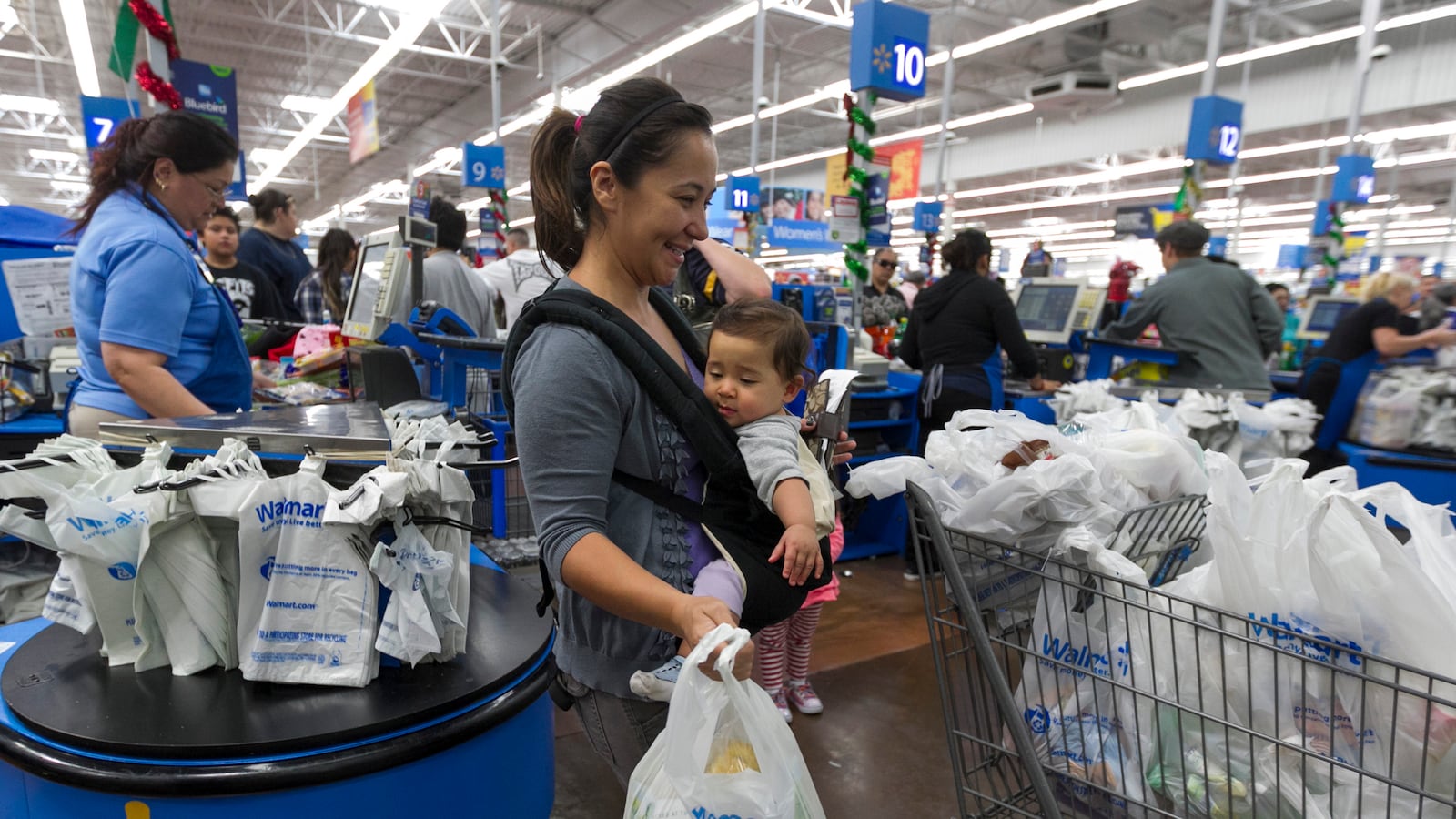Wal-Mart touches more consumers than virtually any other company—140 million customers each week. The registers at its 4,135 U.S. stores ring up millions of transactions every day. Its sophisticated IT systems collect a wealth of information about the supply chain, the behavior of consumers, and real-time action in the consumer economy. And yet at some level, America’s largest retailer remains remarkably clueless about what is happening in the economy.

Even though the economy is growing, its sales aren’t. Strangely, fewer people are coming into Walmart’s stores. Traffic at stores open more than a year fell .4 percent in the third quarter from the year before, and as a result same-stores sales fell .3 percent. Yet the company doesn’t seem to know why. And the pronouncements it makes should lead observers to think twice about whether the company is missing the forest for all the trees.
Consider. If the government telegraphs that food stamps are going to be cut—and may be cut sharply in the future—you might expect the people who depend on them to start taking evasive action, perhaps by saving more and shopping less. Walmart cashes about 18 percent of food stamps in the U.S. Ergo, any cut would be bad news for the company. But as I noted, Bill Simon, president and chief executive of Walmart U.S., last month said (PDF) the cuts could actually work to the company’s benefit. Simon said that “when the benefits expanded, our market share actually went down.” (Translation: When people had more money to spend, they were more likely to go to places other than Walmart.) And so with customers who lose benefits becoming more price-sensitive—“in other words, everybody’s benefit is going to get cut, price will become more important. And when price is more important, we’re more relevant.” That reasoning was wrong, apparently. Last week, when Walmart announced disappointing quarterly sales, Simon said the coming fourth quarter could be tough because of “recent SNAP reductions.”
Another example of macro-cluelessness came in Monday’s Wall Street Journal. Businesses have been complaining about how the Affordable Care Act will affect their own operations from day one. Now some are saying it is already negatively impacting consumer behavior. Never mind that one of the first planks of the ACA to be implemented put money into the hands of consumers; some $504 million in rebates were sent out earlier this year. And never mind that the balance sheets of hundreds of thousands of poor people— the type of people who shop at Walmart—are being improved because of the expanded eligibility for Medicaid. Since October 1, in fact, states have signed up more than 400,000 people for Medicaid—which is to say, free healthcare. And never mind that none of the people who have signed up for insurance plans, many of which are subsidized, has to make a payment until December. And never mind, further, that the penalty for not signing up, which will be leveled at some point in 2014, starts at about $95 and can’t be higher than one percent of a person’s income. Walmart is convinced that the higher costs associated with the ACA are inhibiting the capacity of consumers to spend—even though it acknowledges there is no empirical evidence to support this contention. From the Journal article: “While it is not coming through in customer research, we do know that some of our customers are concerned about the impact of the Affordable Care Act,” Carol Schumacher, vice president of investor relations, told analysts on Thursday. “For many of our customers, having to afford health care and insurance may be another line item in their personal budget that they may not have had to cover previously.”
Finally, on Monday, the internet was aflame with outrage over an extremely telling anecdote from a single Walmart store. It seems that in an employee-only area in a store in Canton, Ohio, Walmart had set up bins to solicit food donations from Walmart workers to help feed… other Walmart workers. The Cleveland Plain Dealer has the depressing story here. A sign above the bins reads: “Please donate food items here, so Associates in Need can enjoy Thanksgiving Dinner.” Now, the article notes that this decision was taken at the store-level, and that Walmart has a series of policies and vehicles through which Walmart employees kick in funds for an employee assistance fund.
But this is insane. And it’s a great metaphor for what is happening in the U.S. economy. “That captures Walmart right there,” Kate Bronfenbrenner, director of labor education research at Cornell University’s School of Industrial and Labor Relations, told The Plain Dealer. “Walmart is setting up bins because its employees don’t make enough to feed themselves and their families.”
This—not the food stamps cut, or the ACA, or the government shutdown—is the real reason for Walmart’s continuing sales struggles. Low-wage workers, four plus years into the recovery, aren’t getting paid enough to consume more. Employers large and small, while sitting on record amounts of cash and ringing up record amounts of profits, don’t feel compelled to share the bounty with employees. Labor share of national income is at a post-World War II low. This has real world implications. Walmart, of course, is the nation’s largest private-sector employer, with 1.4 million employees. Aside from accounting for a big chunk of overall retail employment, Walmart sets the benchmarks and norms for a large part of the service industry. The company’s sales are stagnating in part because it doesn’t pay its employees sufficient wages, and because many other companies follow suit. Yes, Washington may be playing a role in Walmart’s travails. But the real source of the problem is in Bentonville.
The irony, off course, is that, despite all the bad press and the stagnant sales, Walmart’s stock is doing quite well. International sales are growing at a rapid clip, the company pays a decent 2.4 percent dividend yield, and the stock market is generally roaring. Meanwhile, year after year, Walmart’s U.S. operations show an impressive ability to squeeze higher operating profits out of stagnant sales—in part by riding herd on costs such as wages.
It’s great that Walmart has a culture in which employees rally around one another in times of need. But if your employees need assistance to set their Thanksgiving table, it’s a sign that there might be a problem with your business model.






